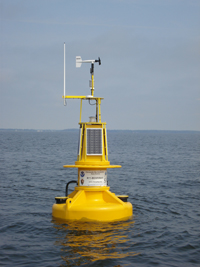NOAA Deploys "Smart Buoy” at Mouth of Susquehanna River
Buoy Features Experimental Nutrient Sensor
September 12, 2008

High resolution (Credit: NOAA)
NOAA's Chesapeake Bay Office will deploy a new edition of its series of “smart buoys” at the mouth of the Susquehanna River on Sat., Sept. 13, to monitor the bay's changing conditions.
U.S. Sens. Barbara Mikulski and Benjamin L. Cardin and U.S. Rep. C.A. “Dutch” Ruppersberger, along with retired Navy Vice Admiral Conrad C. Lautenbacher, Jr., Ph.D., under secretary of commerce for oceans and atmosphere and NOAA administrator, will commemorate the deployment at 10:30 a.m. at Concord Point in Havre de Grace, Md.
A part of the Chesapeake Bay Interpretive Buoy System, this is the fifth interpretative buoy to mark the Capt. John Smith Chesapeake National Historic Trail. The new buoy will feature a sensor to track nutrient levels as they enter the bay from the river,
The buoy, like others in the system, will collect weather, oceanographic, and water-quality observations, and transmit this data wirelessly in near-real time. The Susquehanna buoy will also feature a new sensor, designed to track levels of nitrogen in the water. High levels of nutrients, including nitrogen, have a strong connection to deterioration of the bay’s health, and can contribute to low dissolved oxygen levels in bay waters which create areas known as "dead zones."
“The new sensor will help NOAA monitor nutrient input — a key way to track the health of the bay,” said Lautenbacher. “It will help us understand better how the watershed inputs can affect the health of dynamic ecosystems like the Chesapeake which in turn affects the health of the ocean.”
Observations from the buoys, as well as historical and seasonal information about the bay, are available online, along with educational resources, and by phone at 1-877-BUOY-BAY (877-286-9229).
“This smart buoy is one smart investment for Maryland and the nation,” said Sen. Mikulski, chairwoman of the commerce, justice and science appropriations subcommittee that funds NOAA. “Every day the Weather Service relies on information from buoys like this one to make weather predictions and to keep citizens and their property safe. This buoy will also provide vital information about the health and changing conditions of the Chesapeake Bay. I am proud to fight in the U.S. Senate to put funds in the federal checkbook that support critical Maryland initiatives like these.”
“The Susquehanna buoy is more than just an important addition to the Capt. John Smith Chesapeake National Historic Trail,” said Sen. Cardin. “This innovative buoy system will provide real-time data to boaters, help scientists gather critical information about the nutrient and ecological health of the Chesapeake Bay’s watershed, while also providing visitors with information about Capt. Smith’s historic voyages of discovery.”
The system’s buoys have been deployed at the mouths of the Potomac, Patapsco, and Rappahannock rivers, and in the James River off Jamestown, Va. One more buoy will be launched later this month on the Elizabeth River at Norfolk, Va.
The NOAA Chesapeake Bay Office focuses NOAA’s capabilities in science, service, and stewardship to protect and restore the Chesapeake Bay.
NOAA understands and predicts changes in the Earth's environment, from the depths of the ocean to the surface of the sun, and conserves and manages our coastal and marine resources.